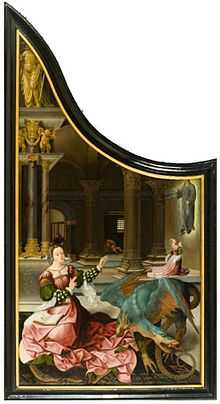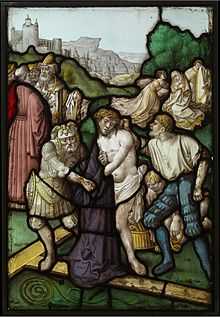Jan Rombouts I

Jan Rombouts I or Jan Rombauts I (alternative first name: Johannes) (c. 1480 in Leuven – 1535 in Leuven), was a Flemish Renaissance painter, glass painter, draftsman, printmaker and glass designer of a religious-themed oeuvre.
Life
The details of the life of Jan Rombouts are sketchy. He signed his work with the monograms IVR and IANR and was as a result for a long time wrongly identified with Jan van Rillaer II, the master painter of Leuven. The earliest known archival document in which Jan Rombouts is listed as 'Johannes Rombouts pictor' dates from 1508. He was mainly active in his hometown Leuven.[1]
His son Jan Rombouts II also became a painter. His daughter Marie married Jan Willems, a painter in Leuven. He was the grandnephew of the glass painter Claes Rombouts.[1] Jan Rombouts was dean of Leuven’s city administration and also served on the board of governors of an Antonine chapel.[2]
His son (ca. 1505–59) worked in his father’s workshop and also held public offices in Leuven, such as that of alderman. Only the son is documented as a glass-painter but the evidence seems to indicate that Jan Rombouts I was also a glass-painter.[3]
Work
_and_The_Conversion_of_St._Paul_(right)%2C_by_Jan_Rombouts%2C_c._1522-1530%2C_view_4_-_Museum_M_-_Leuven%2C_Belgium_-_DSC05047.jpg)
Jan Rombouts is regarded as an important modernizer through his complex compositions, moving figures, lively and colourful palette, meticulous eye for detail and pseudo-Renaissance architectural elements.[4] He thus introduced the innovations of Bernard van Orley and the Antwerp school in Leuven. At the same time he remained faithful to the traditions of his famous fellow townsman Dieric Bouts.[3]
His oeuvre is now believed to comprise four paintings, in the form of three double-sided altarpiece wings and a single panel, seven engravings, a drawing on wood panel of The Judgment of Solomon, a vidimus drawing for a four-light church window (Amsterdam, Rijksmuseum) and more than two dozen painted glass windows, some of them believed to be after Rombouts’ design rather than by the master himself.[2]
His principal panel works are the monogrammed wings of a dismembered altarpiece on the Conversion of Saint Paul and The Fall of Simon the Magus (now in the M - Museum Leuven) which are monumental and in a classicizing style.[2]
His engravings reflect the influences of his contemporaries Albrecht Dürer and Lucas van Leyden.
A monogrammed drawing The Judgment of Salomon dated 1528 (Gemäldegalerie, Staatliche Museen, Berlin) is a design for a glass-panel. The stained glasses from the former Carthusian monastery in Leuven (parts of which are now in New York’s Metropolitan Museum and the Riverside Church) have been attributed to Rombouts and his workshop.[2]
References

- ↑ 1.0 1.1 Jan Rombouts (I) at the Netherlands Institute for Art History (Dutch)
- ↑ 2.0 2.1 2.2 2.3 Dan Ewing, Review of Yvette Bruijnen, Jan Rombouts: The Discovery of an Early Sixteenth-Century Master in Louvain (Ars Nova 16). Turnhout: Brepols Publishers 2011, in: historians of netherlandish art, Vol. 30, No. 2 November 2013, p. 35-36
- ↑ 3.0 3.1 Till-Holger Borchert, Review of Jan Rombouts: The Discovery of an Early Sixteenth-Century Master in Louvain by Yvette Bruijnen, Renaissance Quarterly, Vol. 65, No. 2 (Summer 2012), pp. 548-549, Published by: The University of Chicago Press on behalf of the Renaissance Society of America
- ↑ Signed, Jan R. A Renaissance master rediscovered on Codart
Further reading
- Yvette Bruijnen, Jan Rombouts: The Discovery of an Early Sixteenth-Century Master in Louvain (Ars Nova 16). Turnhout: Brepols Publishers 2011, 312 pp, fully illustrated. ISBN 978-2-503-52569-3.
Link
| Wikimedia Commons has media related to Jan Rombouts I. |